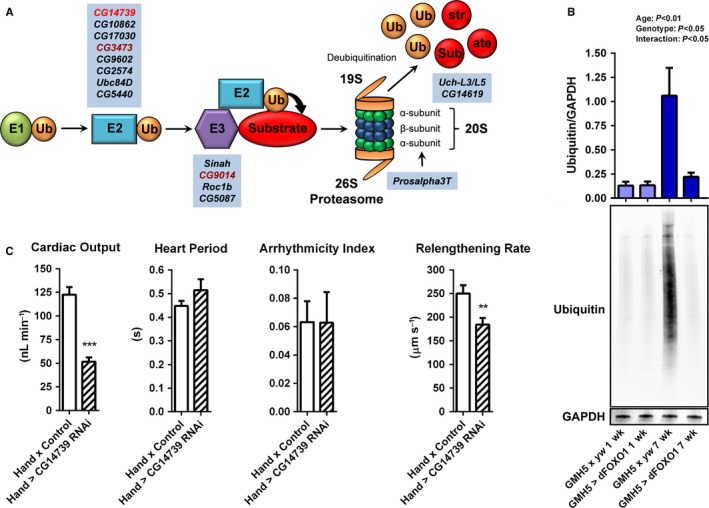Figure 3.

Cardiac‐specific dFOXO overexpression via GMH5‐GAL4 influences the transcription of genes associated with the UPS and reduces ubiquitinated protein content in aged fly hearts. (A) Illustration of the UPS. Ubiquitination of misfolded proteins occurs through a cascade of enzymatic reactions; the E1 ubiquitin activating enzyme transfers activated ubiquitin (Ub) to the E2 ubiquitin conjugating ligase, which then transfers Ub to the substrate, mediated through the E3 ubiquitin ligase. The ubiquitinated substrate is recognized, bound, and degraded by the 26S proteasome, which is composed of the 19S and 20S subunits. Highlighted in blue are fly homologs of UPS‐associated genes whose transcripts were downregulated in control hearts with age and upregulated in dFOXO‐overexpressing hearts (fold change ≥2.0, P < 0.05; Table S1) as determined via microarray analysis (Fig. S5). Upon cardiac‐restricted RNAi‐induced knockdown, the UPS gene in light red induced a premature aging myocardial phenotype, while those in dark red reduced lifespan (Neely et al., 2010). (B) Quantitative western blot analysis was used to probe 1‐ and 7‐week hearts for ubiquitin and GAPDH (loading control). At 7 weeks, control (GMH5 x yw) hearts accumulated a significant amount of ubiquitinated proteins compared to young hearts. Cardiac‐specific overexpression of dFOXO significantly reduced ubiquitinated protein content in 7‐week hearts compared to controls (n = 7–9, two‐way ANOVA, Bonferroni post‐hoc test). (C) CG14739, a conserved E2 ubiquitin conjugating enzyme (Fig. S7), was highly reduced in aged control hearts, whereas dFOXO overexpression caused the transcript's abundance to increase. Cardiac‐specific knockdown of CG14739 significantly reduced output and myocardial relengthening rate (n = 26, **P < 0.01, ***P < 0.001, Student's t‐test) after only 1 week.
